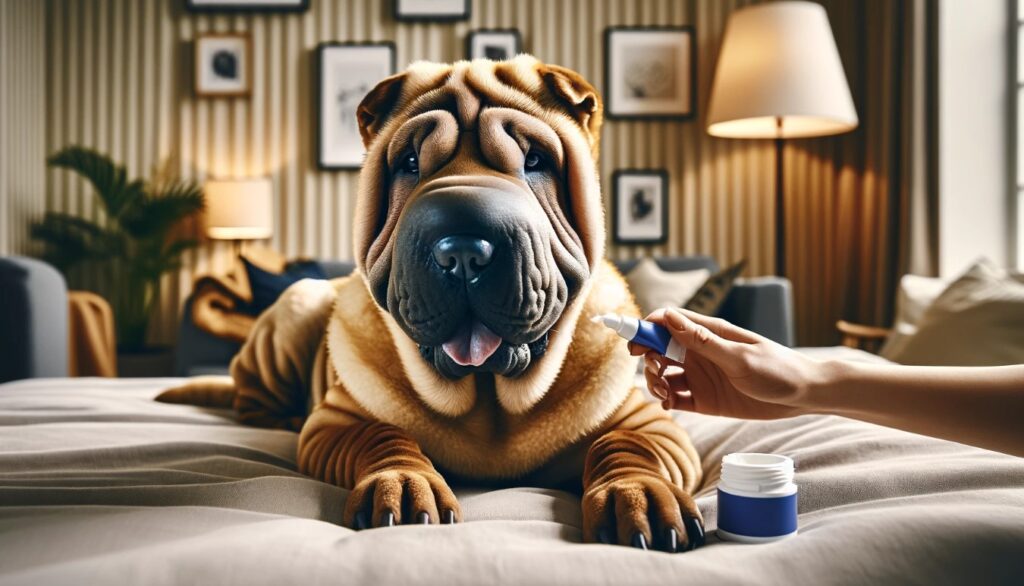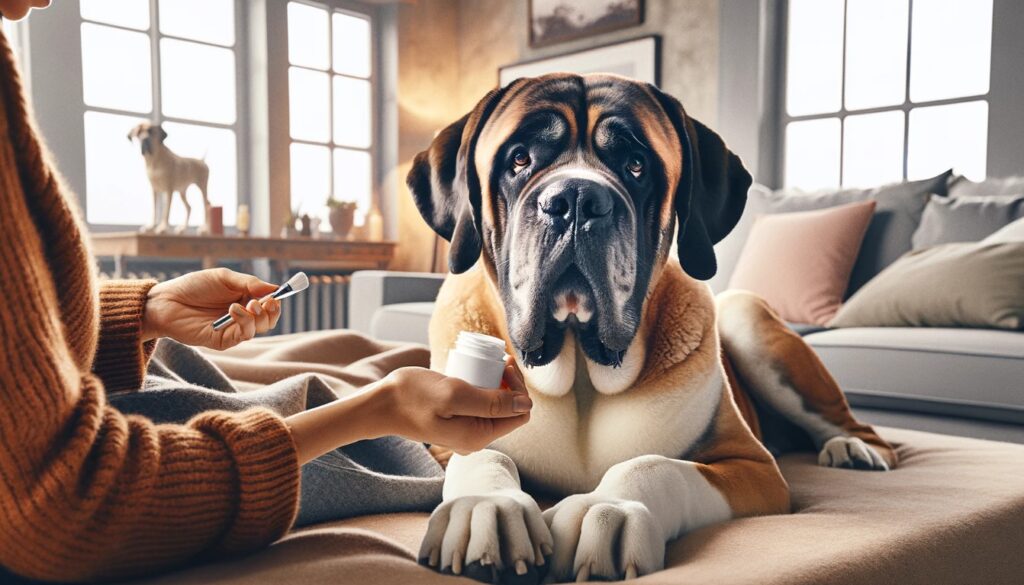Over the years, I’ve encountered countless concerned pet owners who are often overwhelmed by the plethora of information available online, especially when it comes to the health and well-being of their beloved pets. One of the recurring topics I’ve been asked about is the use of antifungal creams for dogs. With the rise in fungal infections, it’s crucial to address this concern head-on. In this blog, I aim to shed light on the effectiveness of over-the-counter antifungal creams, their safety, and when it’s time to consult your vet. My hope is that by the end of this read, you’ll be equipped with the knowledge to make informed decisions for your canine friend. Let’s dive in.

Can I Use Antifungal Cream on My Dog?
Absolutely, this is a question I hear frequently in my practice. As a dog owner, it’s natural to want to provide immediate relief to your pet when they’re in discomfort. However, it’s essential to approach this with caution and knowledge.
First and foremost, not all antifungal creams made for humans are suitable for dogs. Their skin pH is different from ours, and certain ingredients in human products might be too harsh or even toxic for them. Always ensure that the cream you’re considering is labeled safe for pets or has been recommended by a veterinarian.
When applied correctly, antifungal creams can be a lifesaver for dogs suffering from mild to moderate fungal infections. These creams work by breaking down the cell walls of the fungi, effectively killing them and preventing further growth. But remember, the key is to identify the type of fungal infection correctly. Using the wrong treatment can exacerbate the problem or, at the very least, provide no relief.
If you’re unsure about the type of infection or the appropriate treatment, always consult with your vet before applying any medication. It’s better to be safe and get a professional opinion than to guess and potentially make things worse.
In summary, while antifungal creams can be beneficial for dogs, it’s crucial to ensure they’re safe for canine use and are the right treatment for the specific fungal infection your dog has.

Is Antifungal Cream Safe for Dogs?
Safety is paramount when it comes to our furry companions. As a veterinarian, I always prioritize the well-being of the pets under my care, and I understand the concerns many pet owners have regarding the use of antifungal creams on their dogs.
Generally speaking, antifungal creams formulated specifically for dogs or labeled as pet-safe are indeed safe for canine use. These creams undergo rigorous testing and are designed to cater to the unique physiology of dogs, ensuring they provide relief without causing harm.
However, there are a few important considerations to keep in mind:
- Human vs. Canine Formulations: As mentioned earlier, not all antifungal creams made for humans are suitable for dogs. Some ingredients in human antifungal creams can be irritating or even toxic to dogs. Always check the label and consult with your vet if in doubt.
- Application: When applying the cream, ensure it’s done so in a thin layer and rubbed in well. This minimizes the chance of your dog licking it off, which could lead to ingestion of larger amounts than intended.
- Allergic Reactions: Just like humans, dogs can have allergic reactions to medications. Always monitor your dog after the first application for any signs of redness, swelling, itching, or discomfort. If you notice any adverse reactions, discontinue use immediately and consult your veterinarian.
- Duration of Use: While antifungal creams can be effective, they should not be used indefinitely without a vet’s guidance. Overuse can lead to resistance or other skin issues.
- Underlying Conditions: If your dog has any underlying health conditions or is on other medications, it’s essential to discuss with your vet before using an antifungal cream. Some conditions or medications might interact with the cream, leading to complications.
When used correctly and responsibly, antifungal creams can be a safe and effective treatment for various fungal infections in dogs. However, always prioritize your dog’s safety by choosing the right product and consulting with your veterinarian when necessary.
Causes of Fungal Skin Infections in Dogs
Fungal skin infections in dogs can be distressing for both the pet and the owner. These infections can cause a range of symptoms, from mild itching and redness to severe inflammation and discomfort. Understanding the root causes can help in both prevention and effective treatment. Let’s delve into the primary culprits behind these infections:
Allergies:
- Environmental Allergens: Just like humans, dogs can be allergic to various environmental factors such as pollen, mold, dust mites, and certain grasses. When these allergens come in contact with the dog’s skin, they can cause inflammation, making the skin more susceptible to fungal infections.
- Food Allergies: Some dogs are allergic to specific ingredients in their diet. This can lead to skin issues, including fungal infections, especially if the allergic reaction causes the dog to scratch, creating entry points for fungi.
Ringworm (Dermatophytosis):
- Contrary to its name, ringworm is not caused by a worm but by a group of fungi. It’s one of the most common fungal infections in dogs.
- The fungi responsible for ringworm thrive in warm, moist environments. Dogs can contract ringworm from other infected animals, from contaminated objects like bedding and grooming tools, or from spores in the environment.
- Ringworm presents as circular, red, scaly patches on the skin, often with hair loss in the affected area.
Yeast Infections (Malassezia Dermatitis):
- Yeast is a type of fungus that naturally resides on a dog’s skin in small numbers. However, when the skin’s natural balance is disrupted, these yeasts can multiply rapidly, leading to an infection.
- Factors that can trigger an overgrowth of yeast include hormonal imbalances, prolonged wetness (like after a swim), antibiotic use, and underlying immune system issues.
Secondary Infections:
- Sometimes, a primary issue like a bacterial infection, parasitic infestation, or a skin injury can pave the way for a secondary fungal infection. The initial problem weakens the skin’s defenses, making it easier for fungi to invade and thrive.
Immune System Compromise:
- Dogs with weakened immune systems, whether due to age, certain medications, or underlying health conditions, are more susceptible to fungal infections. A robust immune system can usually keep fungal populations in check, but when it’s compromised, infections can arise.
While fungal skin infections in dogs can arise from various causes, understanding these triggers can aid in prevention and targeted treatment. Regular check-ups, a balanced diet, and maintaining a clean environment can go a long way in keeping these infections at bay.

What is the Best Antifungal Treatment for Dogs?
Navigating the world of pet care products can be daunting, especially when faced with the responsibility of choosing the best treatment for your furry friend. When it comes to fungal infections, the right treatment can make all the difference in providing relief and ensuring a swift recovery. Let’s explore the most effective antifungal treatments for dogs:
Antifungal Cream 2% Miconazole:
- Why It’s Effective: Miconazole is a widely recognized antifungal agent that works by inhibiting the growth of fungus on the skin. The 2% concentration is potent enough to combat various fungal infections effectively.
- Benefits: This topical treatment provides direct relief to the affected area, reducing itching, redness, and inflammation. It’s also beneficial in preventing the spread of the infection to other parts of the body or to other pets.
- Application: Ensure the infected area is clean and dry. Apply a thin layer of the cream, rubbing it in gently. It’s crucial to prevent your dog from licking the area for a few minutes post-application.
Other Topical Treatments:
There are other antifungal creams and shampoos available that contain ingredients like ketoconazole, chlorhexidine, and clotrimazole. The choice often depends on the specific type of fungal infection and its severity.
Oral Medications:
In some cases, especially for more severe or widespread infections, oral antifungal medications might be prescribed. These can include drugs like fluconazole, itraconazole, or terbinafine. While effective, they come with their own set of considerations, which we’ll delve into later.
Natural Remedies:
Some pet owners opt for natural remedies like coconut oil, apple cider vinegar, or tea tree oil. While these can offer relief in mild cases, it’s essential to consult with a vet before trying any home remedies. Some natural treatments can be irritating or even toxic if ingested.

Preventative Measures:
Regular grooming, keeping your dog’s living area clean, and ensuring they have a balanced diet can help in preventing fungal infections. Additionally, antifungal sprays or wipes can be used as a preventative measure, especially during humid months or after visits to places where fungi thrive, like dog parks.
While Antifungal Cream 2% Miconazole stands out as a highly effective treatment, it’s essential to consider the specific needs of your dog and the nature of the infection. Always consult with your veterinarian to determine the best course of action tailored to your pet’s unique situation.
How Long To Use Antifungal Creams on Dogs
Determining the appropriate duration for using antifungal creams on dogs is crucial. Over-treatment can lead to resistance or other skin issues, while under-treatment might not fully resolve the infection, leading to recurrence. Here’s a guide on how long to use these creams:
- Follow Veterinary Recommendations:
- First and foremost, always adhere to the duration recommended by your veterinarian. They will provide guidance based on the specific type and severity of the fungal infection your dog has.
- Typical Duration:
- For most mild to moderate fungal infections, a treatment duration of 7 to 14 days is common. However, this can vary based on the specific cream and the active ingredient it contains.
- Monitor the Symptoms:
- While the cream might start showing results within a few days, it’s essential to continue the treatment for the entire recommended period. Stopping early, even if the symptoms have subsided, can lead to a resurgence of the infection.
- If, however, after several days of consistent use, there’s no improvement or the condition worsens, consult your vet immediately.
- Chronic or Severe Infections:
- In cases of chronic or particularly severe fungal infections, extended treatment durations might be necessary. Sometimes, this can be several weeks. Your vet will guide you on this based on regular check-ups and monitoring the progress of the treatment.
- Post-Treatment:
- Once the treatment duration is complete, it’s a good idea to have a follow-up appointment with your vet to ensure the infection has fully cleared. They might recommend additional preventative measures or maintenance treatments, especially if your dog is prone to recurrent fungal infections.
- Prevention is Key:
- After the treatment is complete, focus on preventative measures to reduce the chances of future infections. This includes regular grooming, keeping your dog’s environment clean, and using antifungal sprays or wipes as a preventative measure, especially in humid conditions or after exposure to high-risk areas.
While there’s a general guideline on how long to use antifungal creams, the specific duration should always be determined in consultation with your veterinarian. They will provide the most accurate and tailored advice for your dog’s unique situation, ensuring the best possible outcome.

Oral Antifungals For Minor Skin Infections
Oral antifungal medications are a potent tool in the arsenal against fungal infections in dogs. However, their use, especially for minor skin infections, comes with its own set of considerations. Let’s delve into the topic:
Why They Are Prescribed:
Oral antifungals are systemic, meaning they work throughout the body. They are often prescribed for infections that are widespread, deep-seated, or have not responded to topical treatments.
Why NOT to Use Them for Minor Infections:
Why, as a veterinarian I DO NOT recommend oral antifungal medications as a first line treatment for minor fungal issues on skin. These medications can be effective but there are many risks for organ damage and secondary side effects. They can greatly disrupt your dog’s gut microbiome and can have toxic effects in the kidneys and liver.
- Potential Side Effects: Oral antifungals can come with side effects, including gastrointestinal upset, liver toxicity, or skin reactions. For a minor infection, the risks might outweigh the benefits.
- Resistance: Just as with antibiotics, overuse or inappropriate use of oral antifungals can lead to resistance, making future infections harder to treat.
- Cost: Oral medications can be more expensive than topical treatments, and for minor infections, they might not offer a significant advantage to justify the cost.
Research Study
One international human study published in Acta Obstetricia et Gynecologica Scandinavica found that one treatment of topical medication was 96% effective and the oral antifungal was 98% effective. Given the risks of oral antifungal medications, I recommend using topical antifungal medications- and if the issue doesn’t clear in a week – add in natural immune system support supplements like Standard Process Canine Immune Support, to boost your dog’s immune system. If that also does not work in 2 weeks, then I would go see a vet to get tests and potentially consider oral antifungals if appropriate.
Reference: van Heusden, A. M., Merkus, H. M., Corbeij, R. S., Oosterbaan, H. P., Stoot, J. E., Ubachs, H. M., & Verhoeff, A. (1990). Single-dose oral fluconazole versus single-dose topical miconazole for the treatment of acute vulvovaginal candidosis. Acta obstetricia et gynecologica Scandinavica, 69(5), 417–422. https://doi.org/10.3109/00016349009013305
When They Might Be Considered:
If a minor skin infection is not responding to topical treatments or if there’s a concern about the infection spreading, a vet might consider a short course of oral antifungals. This would be based on a thorough assessment of the situation.
- Monitoring During Treatment: If your dog is prescribed oral antifungals, regular monitoring is crucial. This might include blood tests to check liver function or regular check-ups to assess the progress of the treatment and any potential side effects.
- Alternatives to Oral Antifungals: For minor skin infections, in addition to topical antifungal creams, medicated shampoos, sprays, and wipes can be effective. These provide targeted treatment with minimal systemic effects.
- Consultation is Key: Never administer oral antifungals without a prescription from a veterinarian. They will be able to determine the most appropriate treatment based on the specific type and severity of the infection.
While oral antifungals are a valuable treatment option for certain fungal infections in dogs, their use for minor skin infections should be approached with caution. Always prioritize the well-being of your pet by consulting with a veterinarian to determine the best and safest course of action.
When to Call Your Vet
As a responsible pet owner, knowing when to seek professional advice is crucial. While minor issues can sometimes be addressed at home, there are clear signs that indicate it’s time to call your vet, especially when dealing with fungal infections or any other health concerns. Here’s a guide on when to pick up the phone:
- No Improvement or Worsening Symptoms:
- If you’ve been treating a fungal infection with a vet-recommended antifungal cream and there’s no improvement after several days, or if the condition worsens, it’s time to consult your vet.
- Severe Symptoms:
- Systemic Signs:
- Loss of appetite or refusal to drink water.
- Lethargy or unusual tiredness.
- Vomiting, diarrhea, or any other digestive issues.
- Adverse Reactions:
- If you notice any signs of an allergic reaction after applying a topical treatment, such as increased redness, swelling, hives, or difficulty breathing.
- Behavioral Changes:
- Any sudden or unexplained changes in behavior, such as increased aggression, withdrawal, or signs of depression.
- Recurrent Infections:
- If your dog seems to be getting fungal infections frequently, it’s essential to consult your vet to determine any underlying causes and get a comprehensive treatment plan.
- Concerns with Medication:
- If you’re unsure about the dosage, application, or any other aspect of a medication prescribed to your dog.
- If your dog has ingested any topical treatment or shows any signs of distress after taking oral medication.
- Preventative Care:
- Regular check-ups are vital to ensure your dog’s overall health and catch any potential issues early on. If your dog has had a fungal infection or is prone to them, periodic visits can help in prevention and early detection.
Always trust your instincts as a pet owner. If something doesn’t seem right or if you’re concerned about any aspect of your dog’s health, it’s always better to err on the side of caution and consult with your veterinarian. They are there to guide, support, and ensure the best possible care for your furry friend.

Conclusion
Navigating the health and well-being of our beloved canine companions can sometimes feel like a daunting task, especially with the myriad of information available at our fingertips. Fungal infections, while common, can present a unique set of challenges. However, with the right knowledge, timely intervention, and guidance from trusted veterinary professionals, these issues can be addressed effectively.
In this blog, we’ve journeyed through the essentials of antifungal treatments for dogs, from understanding the causes of fungal infections to the nuances of various treatment options. The key takeaway is the importance of informed decision-making and the pivotal role of regular veterinary consultations.
Your dog’s health and comfort are paramount. By staying informed, vigilant, and proactive, you can ensure that your furry friend remains happy, healthy, and free from the discomfort of fungal infections. Remember, when in doubt, always reach out to your vet. Here’s to many more joyful and itch-free days with your canine companion!
Frequently Asked Questions
A: While some human antifungal creams might be safe for dogs, not all are suitable due to differences in skin pH and potential toxic ingredients. Always check the label and, ideally, consult with your vet before applying any human medication to your dog.
A: Regular grooming, keeping your dog’s environment clean, ensuring a balanced diet, and using antifungal sprays or wipes as preventative measures can help. Additionally, avoid prolonged wetness on your dog’s skin and be cautious about the places where your dog plays, especially during humid conditions.
A: If your dog ingests a small amount of pet-safe antifungal cream, they might be okay. However, if you notice any signs of distress, or if the cream was not intended for pets, contact your vet immediately. It’s always a good practice to prevent licking by distracting your dog for a few minutes after application.
A: Some natural remedies, like coconut oil, have antifungal properties and can provide relief in mild cases. However, for more severe infections or if you’re unsure about the type of infection, it’s essential to consult with a vet before trying any home remedies.
A: The frequency of application depends on the specific product and the severity of the infection. Typically, most creams are applied once or twice daily. Always follow the vet’s recommendation or the instructions on the product label.
